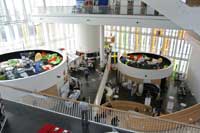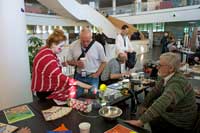Designing a school: taking science out of the classroom Inspire article
How can the architecture of a school influence its teaching? Allan Andersen, head teacher of Copenhagen’s Ørestad Gymnasium, tells Adam Gristwood and Eleanor Hayes.

international festival made
good use of the open spaces
at the Ørestad Gymnasium
in 2011
Image courtesy of Peter Junker,
Gesamtmetall
Take a walk around the breathtaking Ørestad Gymnasiumw1 (upper-secondary school) in Copenhagen, Denmark, and the school might strike you as quite unusual. As you ascend the spiralling timber staircase connecting different parts of the school, you look over students lounging on orange beanbags discussing class work in specialised ‘learning zones’.
You could come across a student film crew working on their latest media project, or a science class dissecting frogs in an open workspace. There are few traditional classrooms and there is certainly no head teacher’s office.
“The design of the building encourages teachers to organise lessons that involve the students more,” explains Allan Anderson, head teacher of the school. “The idea is that teachers talk a lot less and, hopefully, students work a lot more, with more active work, more communication and more knowledge sharing.”
In the four years since the completion of the building, the school (whose students are aged 16-19) has become the most popular in Denmark. Its concept embraces a theme that runs through every class, from media, communication and culture (the school’s profile) to languages, mathematics and science – that the physical design of the building matters. And it is a formula that is working.
“Perhaps students do not learn more in terms of traditional content, but they do learn about co-operation, expressing themselves and working with technology,” Allan says. “For example, because of our strength in media and communications, teachers try to teach science in a different way. They use a lot of videos and virtual laboratories. Instead of traditional experimental write-ups, students might create a podcast or develop an advertising campaign working together with local organisations or industry. Lots of students who have difficulties writing about science find it much easier to talk about it. The school has only been running for four years, so I can’t yet prove it, but I do believe that our students leave with competencies that they don’t gain in the same amount from other schools.”

Ørestad Gymnasium gave
plenty of opportunities for
teachers to swap ideas at the
Science on Stage
international festival in 2011
Image courtesy of Peter Junker,
Gesamtmetall
Teaching takes advantage of innovative workspaces that can be customised according to the needs of the lesson, which can have particular benefits in science classes. “By having a school that is built to enable students to work on their own, you can move away from science teaching that sees teachers demonstrating the same experiments they have used for 30 years, and instead make science more stimulating and hands-on,” Allan says.
Equally important are interactions between teachers and students in large central spaces, rather than in cramped corridors, and through this emphasis on interdisciplinarity and personalisation, the school has been given a heart where social interactions have become a key part of education.
“The idea is that teachers and students should have interactions that move away from that of authority and towards that of colleagues,” Allan explains. “When they know there are teachers around who can help them with their work, then students can develop a responsibility for their own learning.”
There are plans to build in more private space for teachers to ‘recharge’, but the overall goal of a new vision of content, subject matter, organisation and learning remains unchanged. “The school has become somewhat of an icon,” Allan explains. “On a school day, it is a really exciting experience just to walk around and see everything that is happening. In a normal school everything happens behind closed doors, but here you can see everything.”

In April 2011, the Ørestad Gymnasium hosted the international teaching festival of Science on Stage, the network for European science teachers (Hayes, 2011). The spectacular architecture of the school provided a perfect backdrop for the eager exchange of ideas between 350 of Europe’s best teachers.
In April 2013, the next Science on Stage international festival will take place in S?ubice-Frankfurt (Oder) on the Polish-German border, with teachers from 27 countries sharing their most innovative teaching ideas in workshops, on-stage performances and the teaching fair. Each country will be represented by a delegation of teachers selected in a national event.
Participation is free for the delegates. To be considered for your national delegation, contact your national organisers now, as the selection events are already beginning in some countries. There will also be a limited number of places for non-delegates, who will be charged a registration fee. See the Science on Stage Europe websitew2 for details.
References
- Hayes E (2011) Science teachers take to the stage. Science in School 19: 6-9. www.scienceinschool.org/2011/issue19/sons
Web References
- w1 – To read more about Ørestad Gymnasium, see: www.oerestadgym.dk/welcome
- w2 – To learn more about Science on Stage Europe, see: www.scienceonstage.eu
Resources
- For a glimpse inside the Ørestad Gymnasium, see a 24-hour film of the school: www.youtube.com/watch?v=je2Fc4uS9bo





